Publications
Publications
Lessons Learned
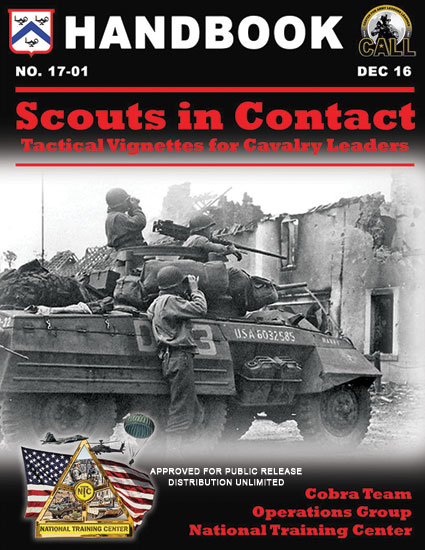 17-01: Scouts in Contact; Tactical Vignettes for Cavalry Leaders Handbook, 8 Dec 16
17-01: Scouts in Contact; Tactical Vignettes for Cavalry Leaders Handbook, 8 Dec 16
Looking for innovative ways to train junior leaders in reconnaissance? Look no further. Vignettes, developed by the subject matter experts at NTC, lead teams through a variety of scenarios that will challenge and mature your young reconnaissance leaders’ decision-making skills. Facilitator instructions guarantee you have the information needed to make you and your reconnaissance teams successful!
Pages
- « first
- ‹ previous
- 1
- 2
- 3
- 4
Handbooks
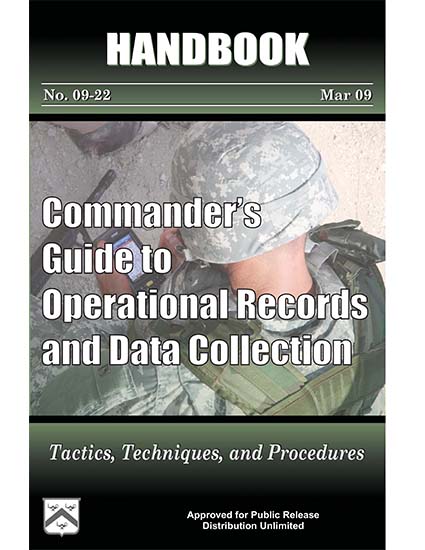 09-22 Commander’s Guide to Operational Records and Data Collection Handbook
09-22 Commander’s Guide to Operational Records and Data Collection Handbook
The Center of Military History (CMH), Records Management and Declassification Agency (RMDA), and Center for Army Lessons Learned (CALL) are all repositories for a unit’s operational records and data. They have jointly prepared this handbook to provide the commander clear guidance pertaining to the preservation and disposition of his unit’s important operational records and data.
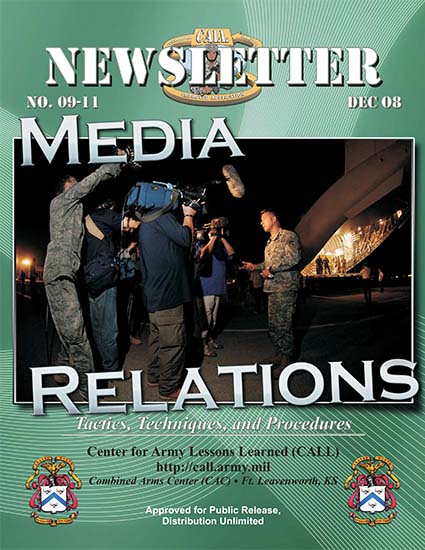 09-11 Media Relations Handbook
09-11 Media Relations Handbook
This newsletter makes the case for changing public relations and media relations to support contemporary operations, especially in a counterinsurgency environment. It explains why commanders, not just the public affairs office, must be involved in public affairs (PA) operations.
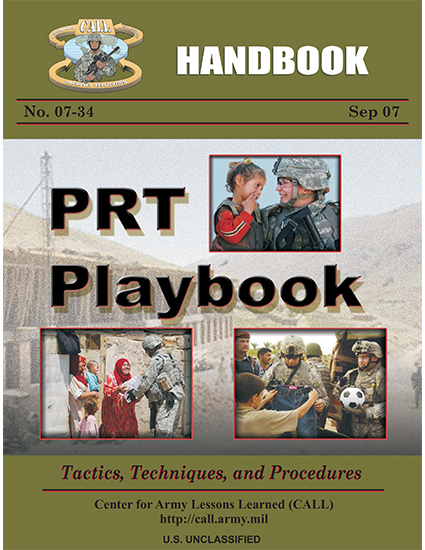 07-34 Provincial Reconstruction Team Playbook Handbook
07-34 Provincial Reconstruction Team Playbook Handbook
Provincial reconstruction teams (PRTs) were established as a result of the need to develop the infrastructure necessary for the Afghan and Iraqi people to succeed in.
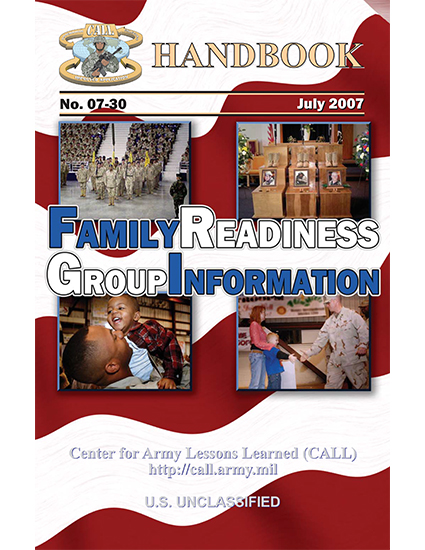 07-30 Family Readiness Group Handbook
07-30 Family Readiness Group Handbook
The Family Readiness Group (FRG) provides an avenue of mutual support and assistance and a network of communication among family members, the chain of command, and community resources. The primary purpose of any FRG is to encourage self-sufficiency among its members by providing information, referral assistance, and mutual support.
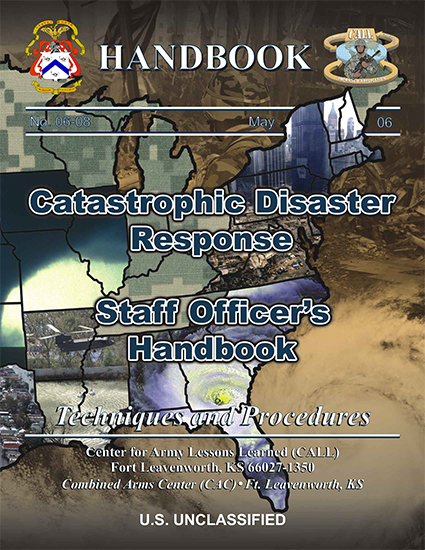 06-08 Catastrophic Disaster Response Staff Officer's Handbook
06-08 Catastrophic Disaster Response Staff Officer's Handbook
After returning to its home station following service in Joint Task Force Katrina, one unit reported that its “staff lacked a general familiarization with civilian disaster response organizations.” The staff officer who trains for and participates in combat operations will experience culture shock when involved in responding to a major domestic catastrophe.
Pages
- « first
- ‹ previous
- 1
- 2
- 3
- 4
Newsletters
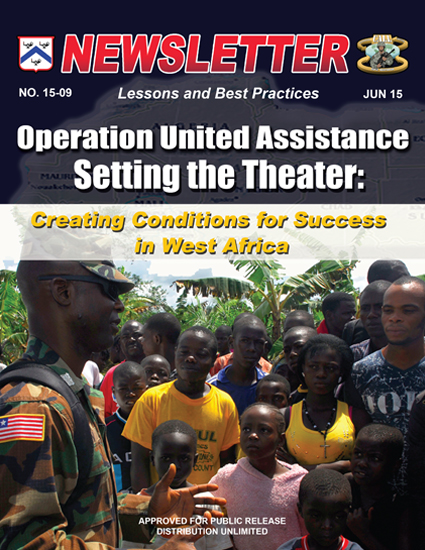 15-09 Operation United Assistance - Setting the Theater: Creating Conditions for Success in West Africa
15-09 Operation United Assistance - Setting the Theater: Creating Conditions for Success in West Africa
Not since World War II has the U.S. military been required to set the theater in Africa. But even more impressive than the empirical accomplishments are the resiliency demonstrated by the people of Liberia in taking the fight to the enemy and the hope which U.S. and international organizations brought to these wonderful people. This publication represents USARAF's efforts to share lessons from OUA. The common thread is a need to foster the capabilities resulting from innovative leadership and adaptive organizations.
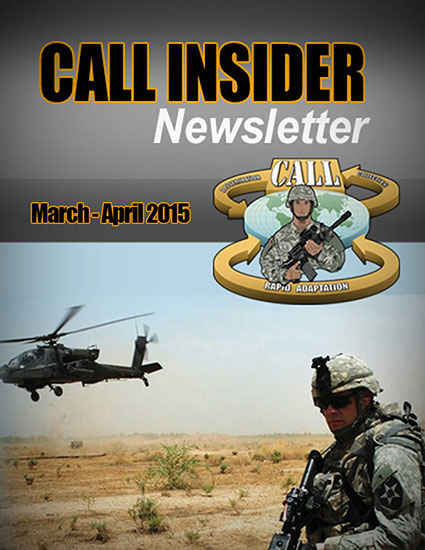 CALL Insider March - April 2015
CALL Insider March - April 2015
CALL continues to support you—the Warfighter—as we execute our Army’s mission. Together we move forward capitalizing on our best practices and learning from our lessons while deployed and at homestation.
At CALL we continue to expand our focus from not only the tactical level of war but across the full spectrum. We have reached out to the ASCCs to see how we can best support them and YOU as your units deploy forward into their theaters of operation.
Some of those highlights are captured in this newsletter as well updates from the training centers, recent publications that are available (hardcopy and digital), and our upcoming work on multinational interoperability.
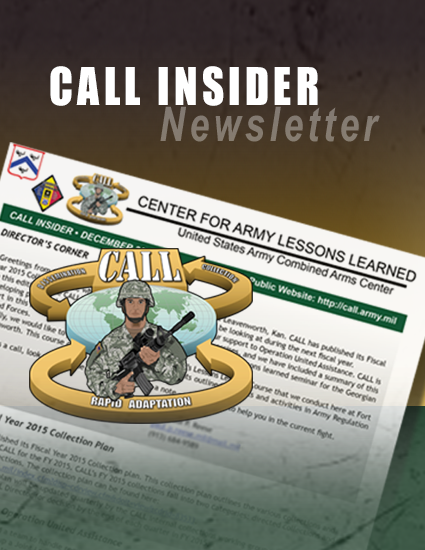 CALL Insider December 2014
CALL Insider December 2014
Greetings from the Army’s premier lessons learned center at Fort Leavenworth, Kan. CALL has published its Fiscal
Year 2015 Collection Plan, which outlines the focus areas CALL will be looking at during the next fiscal year.
In this edition of the CALL Newsletter, we would like to highlight our support to Operation United Assistance. CALL is
developing push packages to assist units in operations or training exercises, and we have included a summary of this
effort in this newsletter. We have also included a summary of our recent lessons learned seminar for the Georgian
Armed Forces.
Pages
- « first
- ‹ previous
- 1
- 2
- 3
- 4
News from the Front
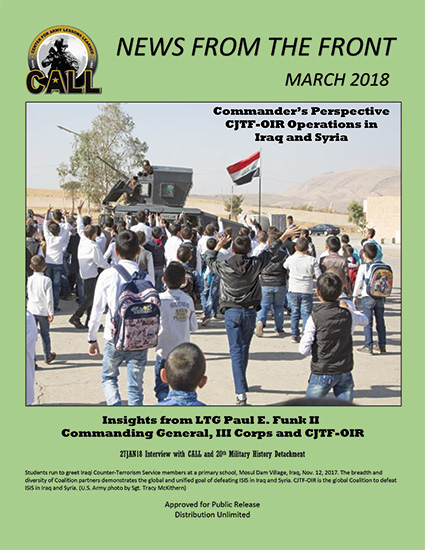 NFTF: Commander’s Perspective CJTF-OIR Operations in Iraq and Syria
NFTF: Commander’s Perspective CJTF-OIR Operations in Iraq and Syria
On 17 October 2014, the Department of Defense formally established Combined Joint Task Force - Operation Inherent Resolve (CJTF-OIR) in order to formalize ongoing military actions against the rising threat posed by the Islamic State of Iraq and Syria (ISIS). III Corps assumed authority from XVIII Airborne Corps on August 2017. Since its inception CJTF-OIR, Coalition, Syrian and Iraqi partnered forces working together have made enormous progress denying ISIS aspirations. This NFTF is a reflection on that progress and the evolution of the battlefield.
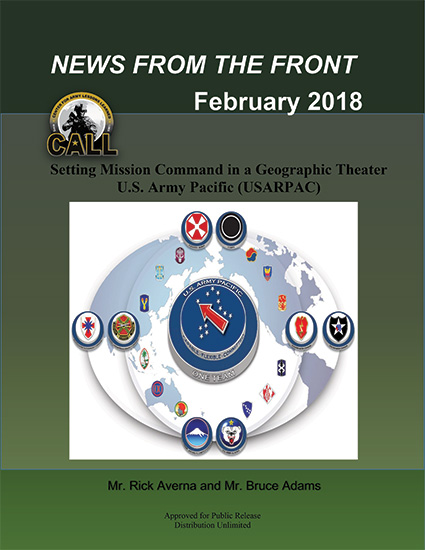 NFTF - Setting Mission Command in a Geographic Theater U.S. Army Pacific (USARPAC)
NFTF - Setting Mission Command in a Geographic Theater U.S. Army Pacific (USARPAC)
Establishing mission command systems is an essential component to setting a geographical theater for military operations and is a core function of the Unites States Army Pacific (USARPAC). Doing so in advance of any contingency operation ensures continuous mission command, and allows headquarters and facilities to be identified, emplaced, and systems to be rehearsed routinely in order to seamlessly command and control Army forces throughout a theater. An Army service component command (ASCC) must set the following mission command conditions: clear lines of command, support relationships, and authorities and the physical structure which allows commanders to have the uninterrupted ability to communicate throughout the depth and breadth of the geographic theater.
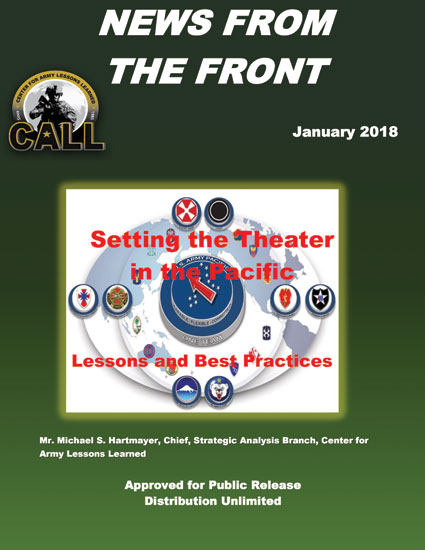 News From the Front: Setting the Theater in the Pacific
News From the Front: Setting the Theater in the Pacific
The purpose of this document is to show, in a publically releasable format, how USARPAC postured land domain capabilities to set the theater and contribute to security and stability in the Pacific region. The insights offered in this document are based on previous collections and therefore are a snapshot in time. As the situation evolves in this theater, so do the support requirements for specific operation plans, concept plans, and other requirements established in the geographic combatant commander’s (GCC’s) theater campaign plan. Therefore, this document merely provides a framework for staff to consider as they ponder and refine their own plans. Other ASCC staff’s may find this a useful model to assist in seeing themselves as they plan to set their theaters.
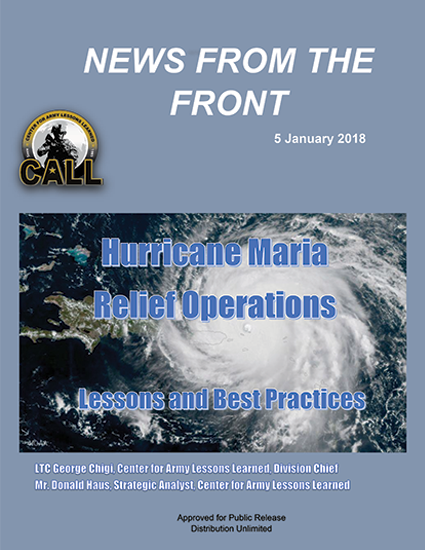 NFTF - Hurricane Maria Relief Operations
NFTF - Hurricane Maria Relief Operations
The purpose of this article is to share initial lessons and best practices observed by the units supporting the relief efforts in Puerto Rico following the landfall of Hurricane Maria. The intended audiences for the Center for Army Lessons Learned (CALL) outputs are Major Commands (MACOMs), interagency partners, and Commanders and staffs executing Defense Support of Civil Authorities (DSCA) missions.
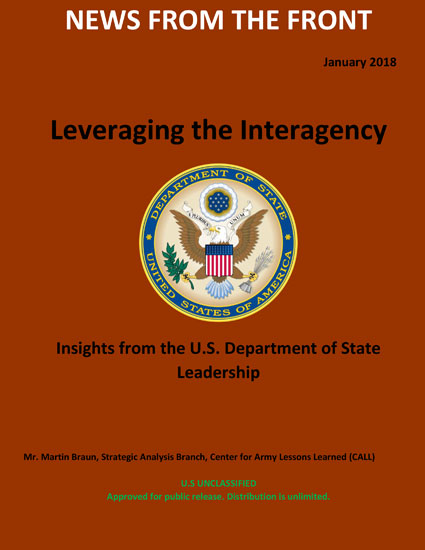 NFTF: Leveraging the Interagency - Insights from the U.S. Dept of State Leadership
NFTF: Leveraging the Interagency - Insights from the U.S. Dept of State Leadership
This Center for Army Lessons Learned (CALL) NEWS FROM THE FRONT (NFTF) provides insights, informed perspectives based on experiences, and highlights lessons and best practices provided by seasoned Department of State (DOS) personnel. The intent is to inform Army and Department of Defense (DOD) personnel at the echelons above brigade (EAB) level about valued skills that DOS personnel bring to the fight, inspire additional exploration and discussion about similarities and differences between the two Departments, and help build a stronger Interagency partnership.
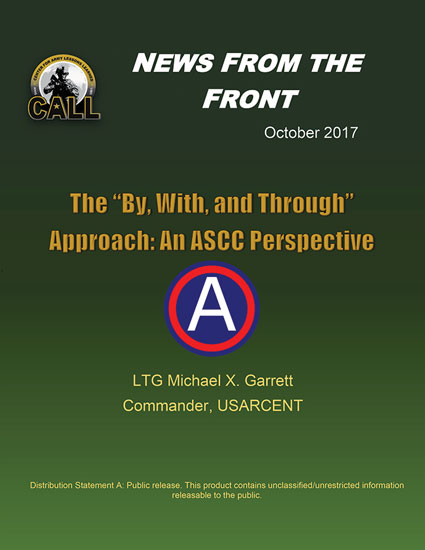 NFTF: The "By, With, Through" Approach: An ASCC Perspective
NFTF: The "By, With, Through" Approach: An ASCC Perspective
This News From The Front (NFTF) highlights the impact of unsettled definitions on the Theater Army’s support to the Joint Force Commander in the BWT prosecution of Operation Inherent Resolve. It examines the By-With-Through (BWT) from the Army Service Component Command (ASCC) perspective. It argues the point of view that the operational approach needs more analysis in order optimally employ BTW. In fact, a deeper understanding of the implications of BWT will very likely inform the future training and preparation for the US Army's Security Force Assistance Brigades (SFAB).
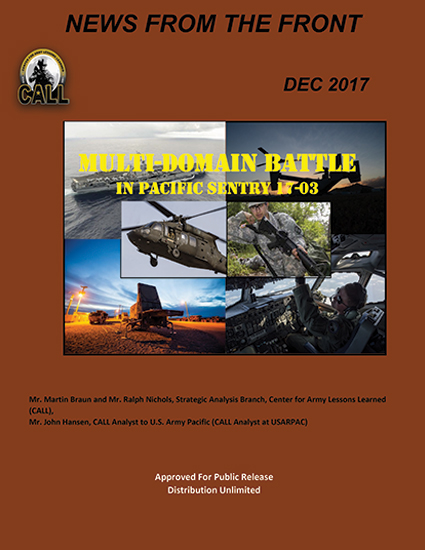 NFTF: Multi-Domain Battle in Pacific Sentry 17-03
NFTF: Multi-Domain Battle in Pacific Sentry 17-03
This News From The Front presents key leader insights, lessons, and best practices in operationalizing the concept of multi-domain battle (MDB) during exercise Pacific Sentry 17-03 as described by U.S., joint, and allied leadership and exercise participants. It provides insights from U.S. Army Pacific (USARPAC), Pacific Air Forces (PACAF), and a multinational partners' perspective (Australia [AUS]). It is the first in a series of publications focused on MDB throughout the Asia-Pacific region that will be used to inform a Center for Army Lessons Learned (CALL) Multi-Domain Battle Special Study.
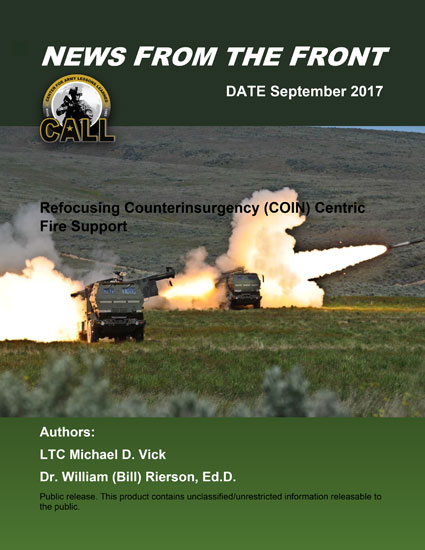 NFTF - Refocusing Counterinsurgency (COIN) Centric Fire Support
NFTF - Refocusing Counterinsurgency (COIN) Centric Fire Support
The United States and its allies must close the fire support gap to achieve a position of maneuver advantage if faced with a large-scale combat operation against a conventional peer threat. The gap must not only be closed in terms of organizing, equipping and manning. Commanders and their staffs must close this gap by refocusing the COIN-centric fire support mindset and begin to synthesize the targeting effort through the lens of a combined arms formation.
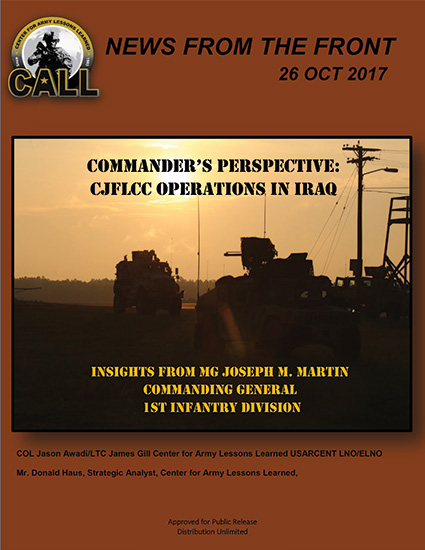 NFTF - Commander’s Perspective: CJFLCC Operations in Iraq Insights from MG Joseph M. Martin Commanding General
NFTF - Commander’s Perspective: CJFLCC Operations in Iraq Insights from MG Joseph M. Martin Commanding General
This News From the Front paper summarizes the key insights from an end of tour interview with MG Joseph Martin, Commanding General (CG), 1st Infantry Division and Combined Joint Force Land Component Command - Operation Inherent Resolve (CJFLCC?OIR). The interview, conducted at the conclusion of his tour, in Iraq on July 12, 2017, contained focus areas that capture best practices and lessons learned during his tenure as the CG.
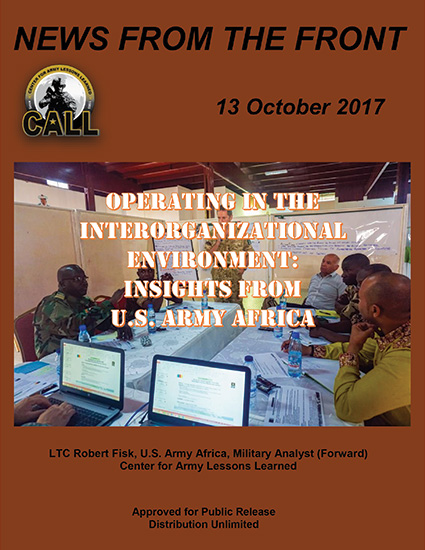 NFTF - Operating in the Interorganizational Environment: Insights from U.S. Army Africa
NFTF - Operating in the Interorganizational Environment: Insights from U.S. Army Africa
U.S. military leaders and planners must understand the purpose and mission of the many governmental, nongovernmental (NGO) and international organizations in the area of operations to facilitate collective cooperation. This paper highlights some challenges the U.S. Army faces when operating in the interorganizational environment and provides insights to enhance collaboration to achieve mutual objectives. These insights were collected during the civilian-led Interorganizational Tabletop Exercise (ITX) conducted in Washington D.C., hosted by the U.S. Institute for Peace (USIP) in conjunction with the Department of Defense (DOD), and the Joint Staff J-7 Exercise Directorate from 17 ? 20 July 2017.
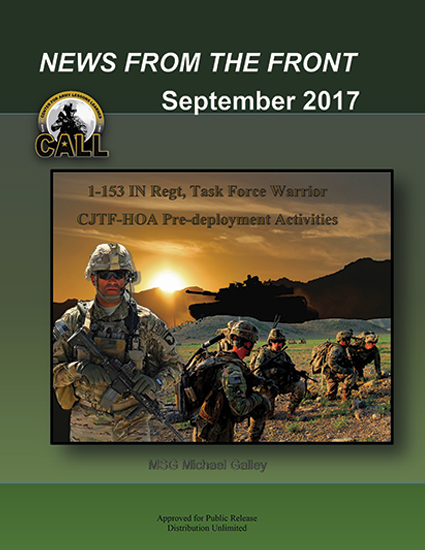 NFTF - 1-153 IN Regt, Task Force Warrior CJTF-HOA Pre-deployment Activities
NFTF - 1-153 IN Regt, Task Force Warrior CJTF-HOA Pre-deployment Activities
The Army Reserve and National Guard participation with the active component providing support for theater security operations and exercise both CONUS and OCONUS has increased drastically over the past 15 years. Army Reserve and National Guard units are given the maximum time possible between the date alerted and the date required to report for active duty. Some units may be alerted, but not actually begin active duty for several weeks. However, under mobilization conditions, an emergency situation may require extremely short active duty notice. This news from the front (NFTF) provides insights into one National Guard battalions mobilization process as it prepared to deploy to the Horn of Africa.
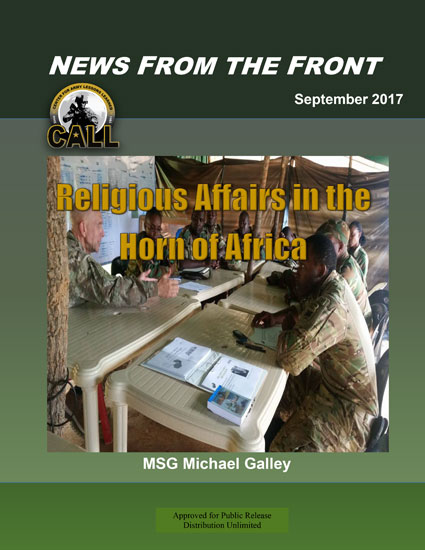 NFTF: Religious Affairs in the Horn of Africa
NFTF: Religious Affairs in the Horn of Africa
U.S. Armed Forces chaplaincies support various joint operations in order to accommodate religious needs, provide religious and pastoral care, and also advise commanders on the complexities of religion with regard to personnel and mission, as appropriate. Religious affairs in joint military operations play a vital role in supporting commanders throughout the operational area, in alignment with the commander's overall theater security program. Religious affairs is not often used by commanders as a "first choice multiplier" during military engagements with our friends and allies; however, it can be effective in building relationships for the long term. This news from the front (NFTF) article discusses a program known as Voices of Religious Tolerance (VORT) which was employed in Afghanistan, Jordan, and Somalia, and provides a way to involve religious affairs to support countering extremist ideas. This NFTF should be useful to religious affairs teams attempting to use this program or build a similar one.
Pages
Other Products
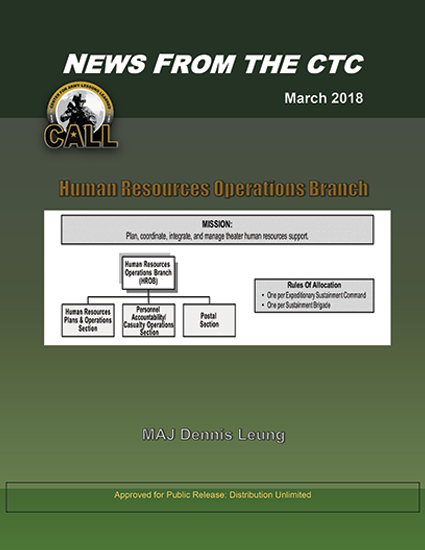 News From the CTC: Human Resource Operations Branch
News From the CTC: Human Resource Operations Branch
The Human Resource Operations Branch (HROB) is a resource manager within the support operations (SPO) section of a Sustainment Brigade (Sus BDE) or Expeditionary Sustainment Command (ESC) responsible for enabling human resource operations within a theater of operations and facilitates the management of our most precious commodity - personnel. However, outside of a deployment, HROBs are seldom employed, and when deployed, HROBs are rarely manned and operated with the experience and technical expertise to be effective.
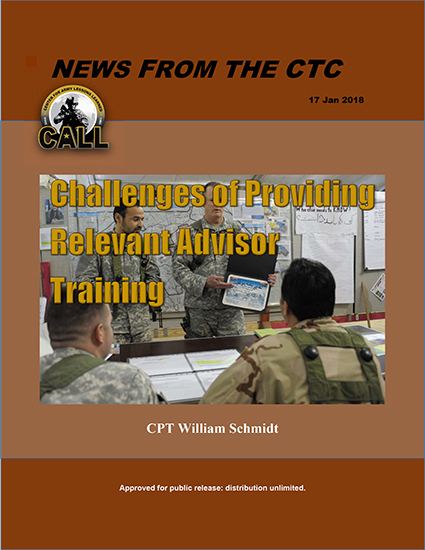 News From the CTC: Challenges of Providing Relevant Advisor Training
News From the CTC: Challenges of Providing Relevant Advisor Training
The author discusses some of the challenges that the Security Force Assistance (SFA) academy faces as one of the staple courses of the 3-353rd AR BN for preparing future advisors. The goal of the academy is to teach the two categories of individual advising skills: Enabling Skills and Developing Skills.
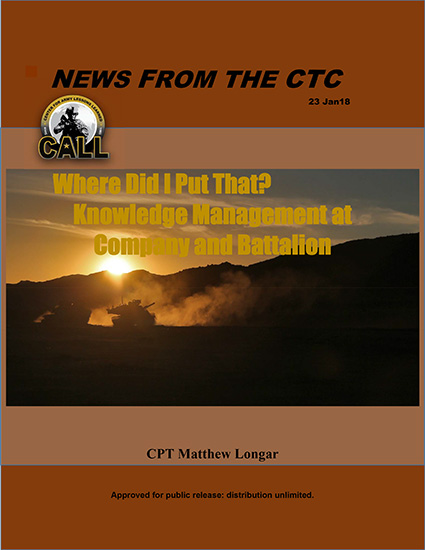 News From the CTC: Where Did I Put That? Knowledge Management at Company and Battalion
News From the CTC: Where Did I Put That? Knowledge Management at Company and Battalion
This article is intended for all units conducting home station training to prepare themselves for a combat training center (CTC) rotation. The author discusses a recurring trend at the Joint Readiness Training Center (JRTC) that one of the more significant debates during JRTC rotations seems to be the challenge of analog versus digital products. While each method has its own merits, each presents its own challenges as it relates to KM. Thus, each method should have associated techniques for ensuring effective knowledge flow to higher, subordinate, and adjacent headquarters.
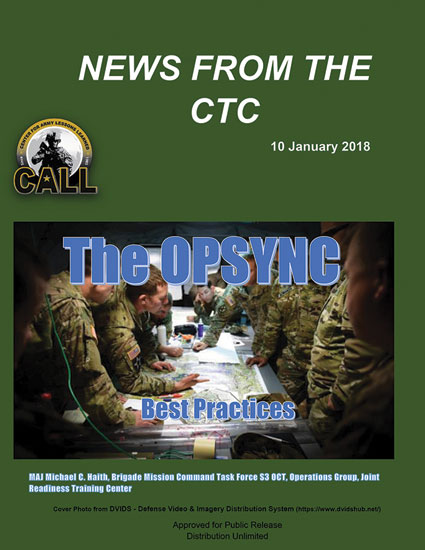 News From the CTC: The OPSYNC Best Practices
News From the CTC: The OPSYNC Best Practices
The Purpose of this document is to inform battalion and brigade leaders and staff on the importance of the operations synchronization meeting, and share lessons, best practices and examples of implementation. This document was informed by more than eighteen months of study, coaching, and mentoring from the JRTC OC/T task forces. The operations synchronization meeting (OPSYNC) is one of the central processes discussed during CTC rotations and is often the point of considerable frustration by battalion and BCT staffs. As a generation of leaders re-calibrate under the decisive action training environment (DATE), staffs are discovering the difficulty associated with harmonizing a diverse combat organization. Arriving at JRTC without developed processes and procedures necessary to synchronize the full capabilities of the BCT, units struggle to achieve mass and maintain momentum through transitions. While this deficiency is likely the result of several contributing factors, the proximate cause is the absence of an organized method to transition concepts into precise action. Ultimately, BCT staffs understand the importance of an OPSYNC, but fail to implement the process in sufficient detail necessary to withstand the complexity and turbulence of the battlefield. Succumbing to the weight of competing demands, the OPSYNC is never fully actualized as the centerpiece of the staff's daily battle rhythm.
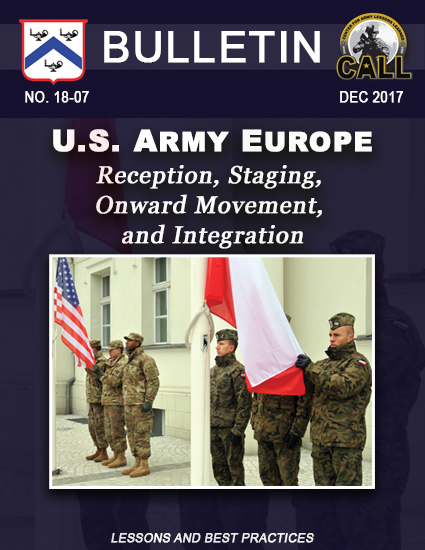 18-07 - U.S. Army Europe: Reception, Staging, Onward Movement, and Integration
18-07 - U.S. Army Europe: Reception, Staging, Onward Movement, and Integration
This bulletin provides lessons and best practices for units deploying to the U.S. Army Europe (USAREUR) area of responsibility (AOR) as well as units supporting (theater and strategic enablers) these deployments. Specifically, it chronicles the deployment of 3rd Armored Brigade Combat Team (ABCT)/4th Infantry Division (ID), located at Fort Carson, CO, to Poland in support of Operation Atlantic Resolve (OAR). The bulletin addresses questions within Army Warfighting Challenge Learning Demand No. 20, Develop Capable Formations.
 18-05 - Strategic Landpower in Europe Special Study
18-05 - Strategic Landpower in Europe Special Study
U.S. ground forces are transitioning away from a period of sustained large-scale counterinsurgencies and preparing for future conflicts. The evolution of ground operations foretell a synthesis of counterinsurgency versus traditional warfare, unconventional versus conventional, and irregular versus regular for future military engagements in Europe. Through a review of the geopolitical environment and strategic and operational theater missions, this study examines not only the role of the ASCC in theater, but also lessons and best practices that can be leveraged for future missions. The primary objective of this special study is to inform Army and joint leaders, and their staffs about the current state and future evolution of U.S. landpower in Europe. The intent is to provide a holistic overview of current landpower in Europe. Staffs, Soldiers, and leaders of USAREUR; its enablers; and the units stationed, deployed, and rotating through Europe can use this study to develop an understanding of the operational environment not available elsewhere. Army Service component commands (ASCCs) and units in other areas of responsibility may find this study a useful model for "seeing themselves." The primary target audience is the theater ground component commander and ASCC staffs. The secondary audience includes Department of Army staff, joint staff, and unified action partners.
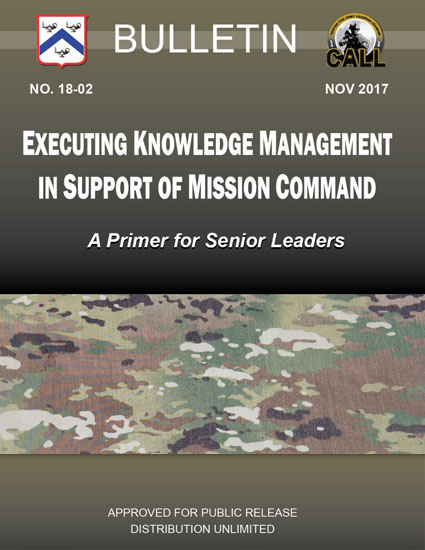 Bulletin 18-02 - Executing Knowledge Management in Support of Mission Command: A Primer for Senior Leaders
Bulletin 18-02 - Executing Knowledge Management in Support of Mission Command: A Primer for Senior Leaders
This primer was developed using lessons learned from Soldiers in the field and the Combat Training Centers, has been prepared by the Army Knowledge Management Proponent. It is intended to provide senior Army leaders a concise understanding of KM and what they can do to improve important organizational processes (e.g., the military decisionmaking process and operations process). It briefly discusses basic KM concepts, the roles of senior leaders in KM, and provides some techniques senior leaders may choose to employ in managing a KM program.
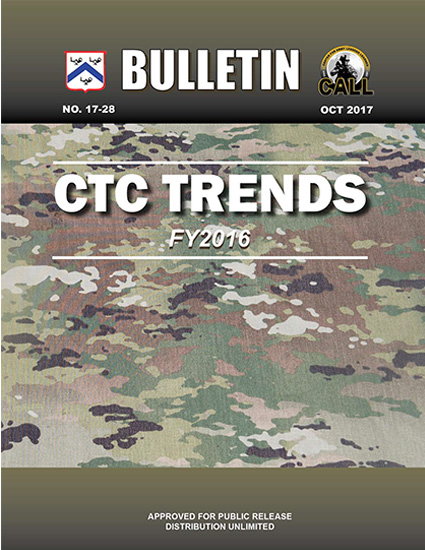 17-28 - CTC Trends FY16 Bulletin
17-28 - CTC Trends FY16 Bulletin
This CTC Trends Bulletin identifies trends for fiscal year 2016 across the CTCs, based on observations from observer–coach/trainers (OC/Ts) and collection and analysis teams from the Center for Army Lessons Learned (CALL), with support from various Army Centers of Excellence. A trend is defined in Army Regulation 11-33, Army Lessons Learned Program (14 JUN 2017), as “an identified issue or best practice supported by three or more observations from multiple sources within a reasonable period.” CALL collects observations, best practices, and training results from OC/Ts at the CTCs; analyzes them; and compiles them annually in a publication. Organized by Army tactical tasks from the Army Universal Task List, these CTC trends reflect both positive performance (sustains) and areas that need emphasis (improves). CTC trends provide valuable information to units developing and executing training for deployment to a CTC or an operational environment. Each chapter includes recommendations for units to successfully execute identified tasks. This provides a reference for training emphasis at home station. Additionally, identifying and analyzing trends allow doctrine writers, training developers, and other Army problem solvers to receive successful techniques and identify gaps in capability for doctrine, organization, training, materiel, leadership and education, and personnel and facilities (DOTMLPF) solutions. Applying the lessons learned at the unit or the institutional level from trends that are identified enables the Army to be a continually learning organization.
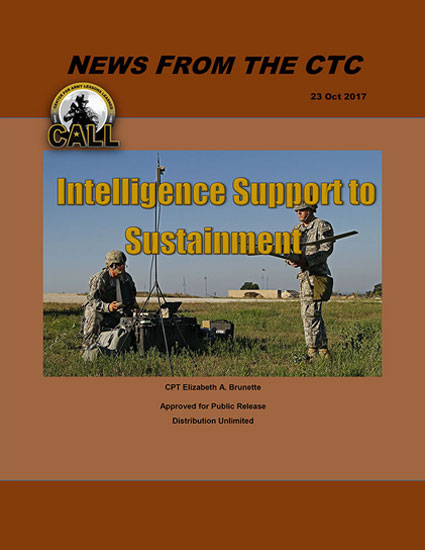 News from the CTC: Intelligence Support to Sustainment
News from the CTC: Intelligence Support to Sustainment
Today’s Army Logisticians rely on a robust intelligence enterprise to provide timely and accurate information to deter threats and minimize interruptions to sustainment operations. Within combat sustainment support battalions (CSSBs), the intelligence cell is required to provide intelligence information to support current and future operations and plans. The Army’s active duty and reserve CSSBs test this support requirement regularly at the combat training centers (CTCs).
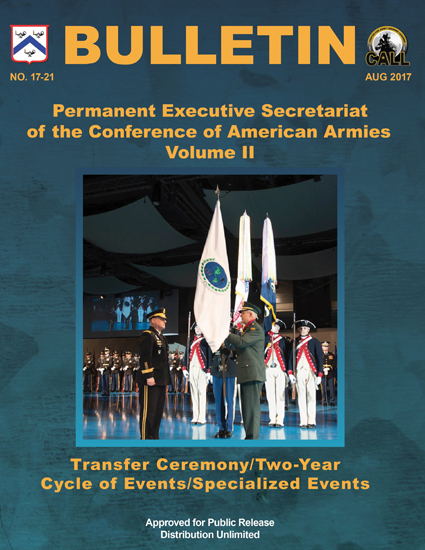 17-21 Permanent Executive Secretariat of the Conference of American Armies Vol II Bulletin
17-21 Permanent Executive Secretariat of the Conference of American Armies Vol II Bulletin
The CAA conducts a two-year cycle of specialized conferences/exercises hosted by different member armies. Each cycle ends in a preparatory meeting that reviews the accomplishments of the previous two-year cycle and approves the agenda for the forthcoming conference and Commander's Conference of the American Armies (CCAA). The CCAA is conducted by the army hosting the Permanent Executive Secretariat CAA (or PESCAA) for that particular cycle. Hosting of the PESCAA voluntarily rotates every two years. The host nation serves as the CAA headquarters responsible for coordinating all current cycle CAA activities in addition to hosting the preparatory meeting and commander?s conference. This bulletin contains valuable information to inform leaders from all conference member nations on the goals, processes, and procedures as a contributing army and prepares them to assume the critical role of leading the PESCAA in the future. This publication is the second volume, in a series of three, produced for the CAA. It is a ?how to? guide outlining the structure and operation of the two-year cycle of events, culminating in the transfer ceremony of the CAA cycle.
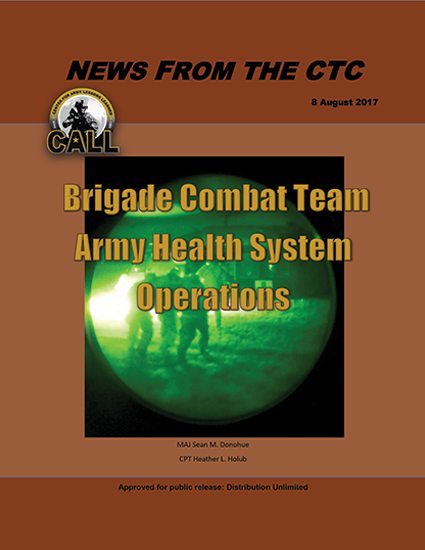 News from the CTC Brigade Combat Team Army Health System Operations
News from the CTC Brigade Combat Team Army Health System Operations
News From The CTC written by NTC Medical Observer Controllers. This article discusses medical best practices at the Battalion and Brigade level. Useful for medical professionals, planners and sustainment personnel involved with medical operations.
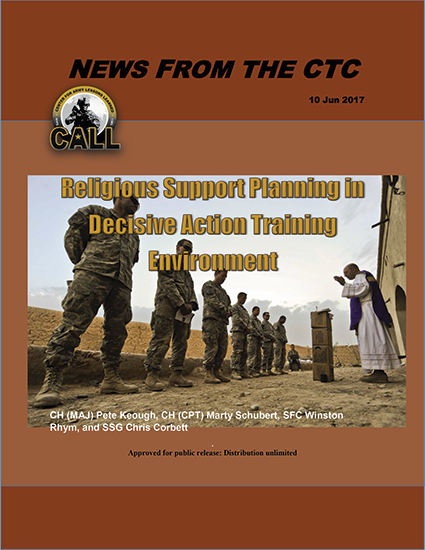 News From the CTC: Religious Support Planning in the Decisive Action Training Environment
News From the CTC: Religious Support Planning in the Decisive Action Training Environment
Unit ministry teams (UMTs) familiar with counterinsurgency and/or unfamiliar with decisive action training environment (DATE) scenarios face numerous challenges when attempting to develop religious support plans. Current challenges facing UMTs include inadequate doctrinal understanding and execution of the operations process; heavy dependence upon past and outdated tactics, techniques, and procedures (TTPs); deficiencies in effective staff integration; and the struggle to understanding roles and responsibilities at the brigade UMT level. In this article, the authors discuss these challenges and provide a way forward for UMTs attending the Joint Readiness Training Center to develop doctrinally sound and integrated religious support plans for DATE scenarios.

